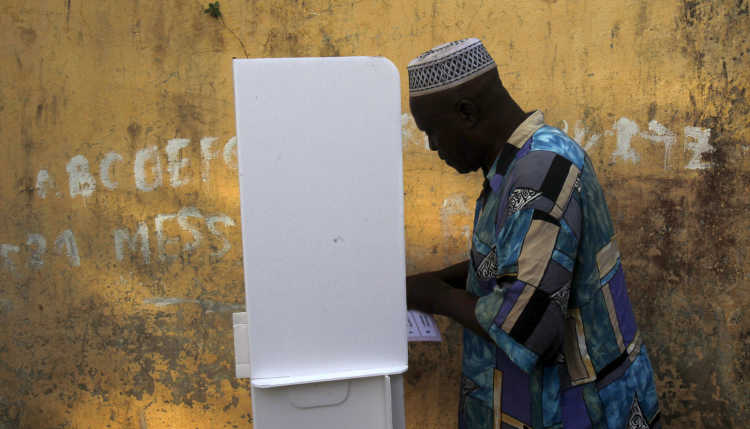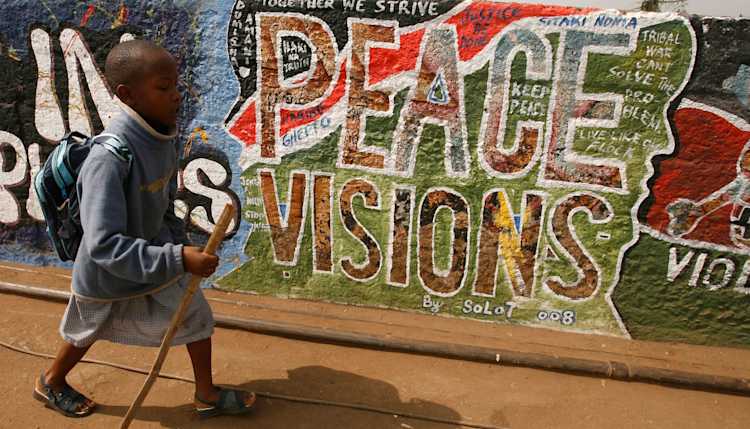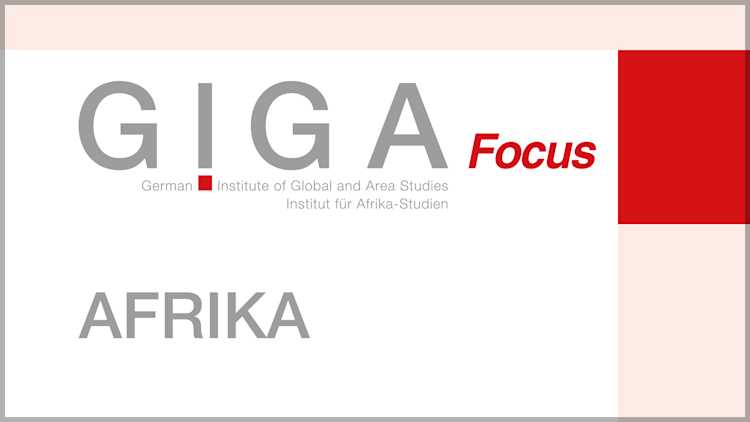- Home
- Publications
- GIGA Focus
- Dealing with New Security Threats in Africa
GIGA Focus Africa
Dealing with New Security Threats in Africa
Number 2 | 2018 | ISSN: 1862-3603
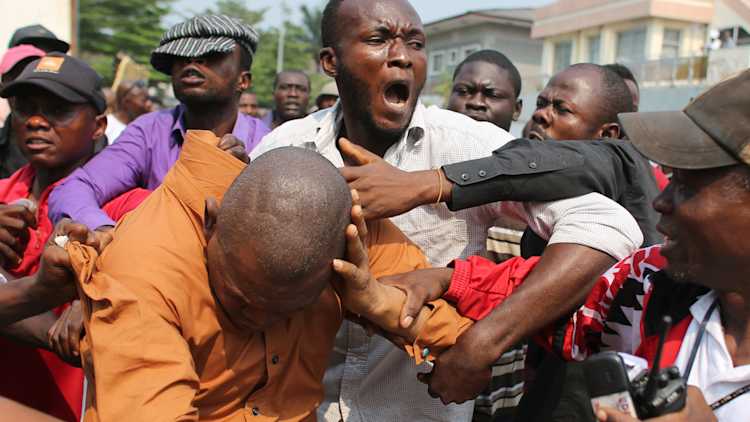
The African continent has made great strides in reducing the number of violent conflicts since the end of the Cold War. Simultaneously, however, the nature of security threats has substantially changed. This requires new regional and international responses to strengthening the security of African citizens.
Insecurity is increasingly driven by the reoccurrence of conflicts in some countries rather than by the emergence of “new” ones. Decentralised forms of violence like terrorism, urban riots, and small insurgencies in state peripheries have been on the rise. Conflicts with strong regional and international involvement have increased.
These changes have been driven by (a), most notably, substantial but highly unequal economic growth in many African countries, (b) (incomplete) democratisation which is often coupled with weak state capacity and bad governance, and (c) various demographic factors, such as strong population growth, rapid urbanisation, and an increasing share of economically and socially deprived youth. Taken together, these factors have created grievances and opportunities for violence that have changed the nature of security threats in Africa.
African and international responses to these security challenges have been hampered by a predominant focus on dealing with ongoing violent conflicts rather than on their prevention and, even more so, post-conflict peacebuilding. Also, conflict management has mainly relied on military means at the expense of broader economic and political approaches that would address the underlying socio-economic and political drivers.
Policy Implications
The changed security conditions require an adapted response by both African and international actors. The international community could enhance its contribution by promoting comprehensive peacebuilding strategies, clearly defining the roles and responsibilities of different actors, and strengthening the development–security nexus. Such a reorientation would make African approaches and international support more effective in addressing the structural causes of insecurity on the African continent.
A Changing Security Environment on the African Continent
Data on insecurity in Africa shows a relatively stable long-term trend that armed intra-state conflict has been on the decline since the end of the Cold War. Similarly, the number of people that have died in armed conflict on the African continent has substantially decreased. Simultaneously, economic, political, and demographic developments have fundamentally changed the nature of violence and insecurity. Four main trends must be taken into account in order to effectively counter current security threats in sub-Saharan Africa:
Increasing conflict recurrence: Present-day violence in Africa is strongly driven by the recurrence of intra-state conflicts rather than by the emergence of entirely new violence. The number of “new” violent conflicts peaked in the 1990s and was subsequently surpassed by recurrent conflicts. Many countries that are engulfed in armed intra-state conflict today have previously experienced phases of instability and violence only interrupted by short intervals of relative peace (see Figure 1). Ongoing crises in South Sudan, Mali, and the Central African Republic are current examples. Although similar trends can be observed globally, they are most pronounced in Africa and the Middle East. Such so-called conflict traps blur the classic dividing lines between the clearly identifiable stages of conflict prevention, conflict management, and post-conflict reconstruction.
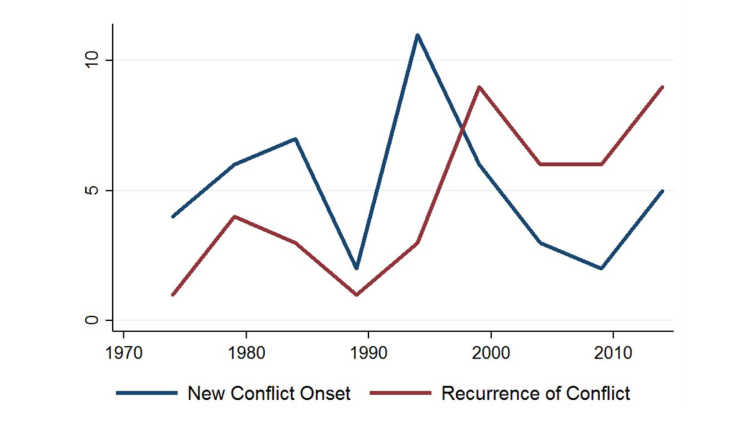
Decentralised forms of violence, terrorism, and organised crime: While organised large-scale political violence over control of the state (armed intra-state conflict) has declined in frequency and intensity, current insecurity is strongly driven by more low-level insurgency in state peripheries (Straus 2012). Moreover, other manifestations of insecurity have gained in importance. As Figure 2 illustrates, terrorist attacks (bombings, assassinations, and kidnappings) have increased significantly since 2010, as have more decentralised forms of violence. According to data from the Armed Conflict Location and Event Dataset (ACLED), riots and violent protests have witnessed the sharpest increase among all security-relevant events in Africa from 1997 to 2013 (Raleigh et al. 2010). Data on clandestine organised crime and drug trafficking is scarce, and we have little hard evidence on its impacts on socio-economic outcomes, including violence and security. Nevertheless, anecdotal evidence suggests that organised crime and the drugs trade exhibit strong negative effects on economies and political systems in highly affected countries like Mali, Guinea-Bissau, and Kenya; though the extent to which it constitutes a direct security threat in sub-Saharan Africa remains unclear.
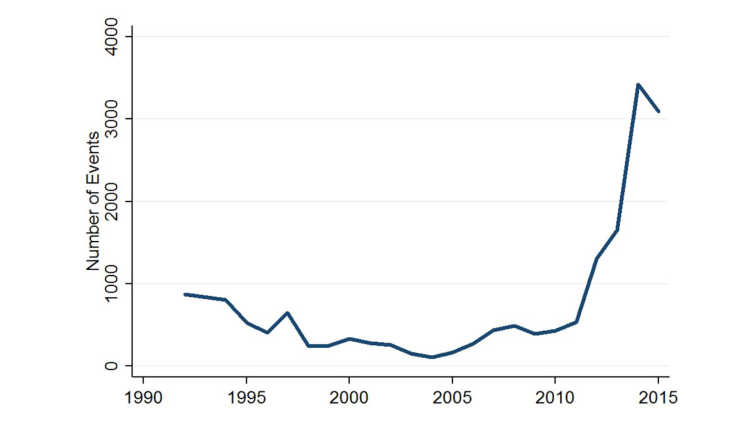
Transnationalisation: An increasing share of violent conflicts on the continent affects multiple countries simultaneously. Since the turn of the century, the absolute and relative number of conflicts with strong international dimensions has increased substantially. As Figure 3 illustrates, over the last decade, the most recent upward trend in the prevalence of armed intra-state conflict has been driven by a steady increase in internal conflicts where other states intervene. Currently, 79 per cent of civil wars in Africa are characterised by cross-border violence, and 29 per cent of conflict actors operate across borders (Deltenre and Liégeois 2016). This can be explained by the increasing range of non-state and substate armed actors (militias, terrorist groups, small and peripheral rebel groups) that regularly cross borders, such as Al-Shabaab in East Africa and Boko Haram in West Africa.
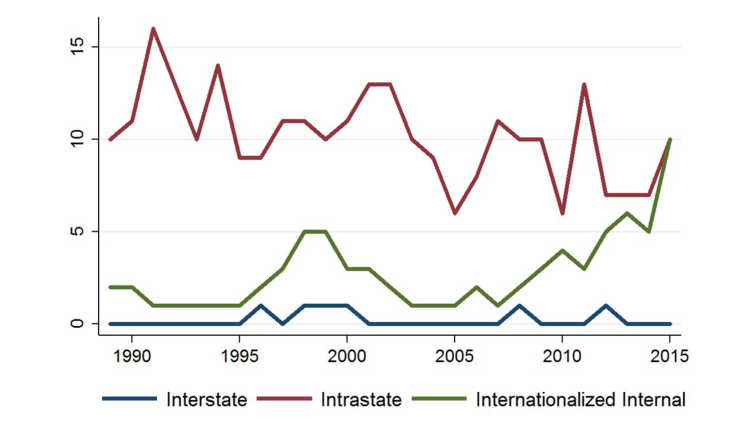
Regional differentiation: The types of security challenges have always varied across African regions and countries (and, of course, even within countries). Similarly, some of the current trends are geographically concentrated. For instance, the number of terrorist attacks has increased in almost all parts of the continent but has been particularly pronounced in eastern, western, and northern Africa; central and, in particular, southern Africa have been less affected. The increasing amount of violence perpetrated by political and communal militias is especially pronounced in eastern and central Africa. Meanwhile, several countries in southern Africa have recently seen comparatively large numbers of often violent demonstrations (Raleigh et al. 2010).
Changing Drivers of Conflict and Violence in Africa
The primary threats to peace and security in Africa are well known: poverty, weak state institutions, and weak governance. Nonetheless, specific economic, political, and demographic developments have contributed to the observable changes of symptoms of violence and insecurity.
Despite relative improvements in a lot of states, the absolute prevalence of poverty and economic inequality has increased in many African countries. This constitutes a risk for intra-state conflict and potentially induces more decentralised forms of violence. Many African countries have experienced high and steady economic growth in recent years, which has led to a substantive decline in poverty rates across the continent. However, as a consequence of pronounced population growth, the absolute number of poor people has increased. Moreover, the benefits of growth are often distributed in a highly unequal way. In fact, Africa as a whole has the highest level of inequality of any region in the world. According to World Bank data, around half of African countries have experienced increases in income inequality in recent years despite reductions in poverty rates (e.g. Rwanda, Chad, and Ethiopia). Importantly, rising inequality is regularly driven by income gaps between regions, identity groups, and urban–rural divides as well as by unequal distribution of resources (including international development aid). The resulting so-called horizontal inequalities are particularly politically destabilising, playing an essential role not only in fuelling armed conflict but also other forms of violence such as urban riots and terrorism (Dowd 2015).
In addition, many African countries are confronted with the depletion of natural resources as a consequence of long-term environmental developments. Africa is among the parts of the world that are most vulnerable to the economic impacts of climate change. Given the importance of agricultural livelihoods on the continent, such developments can contribute to aggravating pre-existing tensions stemming from the political exclusion and economic marginalisation of rural communities. Taken together, these economic developments not only constitute an important element of the complex causes of insecurity on the African continent, they also explain some of the patterns and developments of decentralised forms of violence that characterise most current forms of insecurity.
Overall, Africa has become more democratic since the end of the Cold War. The extension of political and civil rights has been a very positive development that is likely to have contributed significantly to a reduction of large-scale conflict. It is often overlooked, however, that processes of incomplete democratisation may also have fuelled other forms of violence. Democratic setbacks (e.g. manipulations of presidential term limits) and weak governance (e.g. clientelism, corruption, and discriminatory policies) constitute important stability risks, as seen in Burundi and the Democratic Republic of the Congo (DRC). Moreover, the introduction of electoral democracy coupled with weak state institutions has also nurtured more decentralised forms of violence. Prior research indicates that one potential reason lies in the fact that in a lot of countries democratisation has created a political bias towards demographically strong rural areas. While the inclusion of rural elites can help reduce the risk of the emergence of organised rebellions, the political marginalisation of urban areas simultaneously increases grievances and can lead to new forms of political violence in urban settings (Golooba-Mutebi and Sjögren 2017). Finally, in many countries, democratisation has taken place in the context of highly centralised and weak state capacity. Weak services by the state and territories not effectively governed by the state are prone to being captured by non-state armed actors. Entangled networks of militias, terrorist organisations, and criminal organisations in northern Mali and Somalia are cases in point.
Rapid urbanisation increases the risk of unrest and support for radical organisations and terrorist groups. Sub-Saharan Africa’s urbanisation rate (the share of people living in urban areas) has increased from less than 20 per cent in 1970 to nearly 40 per cent today. This trend led to an increase in the absolute number of urban residents by nearly 100 per cent between 1995 and 2015 alone. This demographic development has been accompanied by rising unemployment rates (particularly among the youth) and insufficient infrastructure and service provision by the state. Under conditions of weak governance and economic strain, rapid urbanisation can become a breeding ground for gang violence and riots. Poor and unequal educational opportunities and the socio-economic marginalisation of rural–urban migrants have been found to particularly increase levels of urban violence (Østby 2016). Despite the fact that urban unrest is often considered “low-intensity,” it increases the risk of fragility, which may in turn develop into a substantial security threat (Raleigh 2015). Moreover, individuals and groups living in urban poverty have been found to be at high risk of supporting terrorist organisations (Mousseau 2011).
The increasing number of conflict recurrences in many African countries is not only driven by the unaddressed economic and political issues that led to violence in the first place. Violence in itself begets violence by negatively affecting political institutions, economic development, and intercommunal relations. Moreover, the evidence suggests that different forms of violence mutually influence each other. Organised crime is more likely to flourish where the state has been pushed back as a consequence of previous violent conflict, such as in northern Mali or in Libya. Exposure to violence has been found to generally increase support for radical and terrorist groups. For instance, individuals that have experienced high levels of violence are more likely to normalise aggressive behaviour and become more susceptible to black-and-white ideologies, whereas exposure to communal violence has been found to increase support for violent extremism in Burkina Faso, Nigeria, and Chad (Finkel et al. 2016). Similarly, regions in Kenya, Mali, and Nigeria that have experienced forms of conflict in the past have become particularly prone to Islamist violence.
Devising Effective African and International Responses to Changing Security Challenges
Regional and international initiatives are a key route to address insecurity on the African continent. Concurrently, strengthening peace and security on the continent has been one of the main concerns of the African Union (AU). Its African Peace and Security Architecture (APSA) is the primary framework for developing and implementing African solutions for peace and security on the continent. In particular, the APSA outlines “the system (roles, instruments and procedures) by which the AU, the RECs [regional economic communities] as well as the RMs [regional mechanisms] can realise their conflict prevention, management and resolution mandates” (African Union Commission 2015). However, despite notable successes, the APSA is ill-equipped to comprehensively deal with the various forms of conflicts and the multiple causes introduced above.
The AU is seeking to strengthen the own funding of its peace activities in order to achieve its ambitious goal of “silencing the guns” by 2020. Consequently, the AU Assembly decided in 2015 to take financial responsibility for 25 per cent of the costs for peace activities on the African continent by 2020 (excluding the African Union Mission in Somalia, AMISOM). Following the recommendations of the Kaberuka Report (African Union 2016), the key instrument for collecting and distributing these funds will be the AU Peace Fund, which will serve as a financing mechanism for realising the AU’s goal of providing “greater investment in Mediation, Preventive Diplomacy and Institutional Capacity” (African Union 2016: 7). In addition to bundling AU member state contributions, the Peace Fund might also be directly supported by the AU’s external partners, most notably the EU, which currently (2016) covers 98 per cent of the costs of AU peace initiatives.
However, raising funds and creating new funding procedures is just one of the challenges that need to be addressed to devise more effective responses to insecurity on the African continent. One key imbalance that has prevented African institutions and their international partners from more effectively addressing the key causes and new forms of insecurity in sub-Saharan Africa is the APSA’s focus on military responses to escalated conflicts over sustainable peacebuilding. Most importantly, the ASPA does not focus on addressing the underlying causes of the above-described economic, political, and social tensions. Moreover, the primary APSA instruments in this area (most notably, peacekeeping and mediation) have been designed with the objective of countering instances of large-scale organised violence such as armed conflicts or civil wars. While this specific form of violence continues to be an important threat to peace and stability on the continent, more decentralised and low-level forms of violence dominate now. Thus the main elements of the APSA, such as early warnings and international interventions, are less suited to addressing these types of violence.
As outlined, “new” threats such as terrorism and violent extremism characterise insecurity on the African continent. In response to these challenges, the APSA and the AU’s international partners should rebalance their approach to systematically strengthen the development–security nexus. This requires implementing more-comprehensive conflict-prevention and peacebuilding strategies to help reduce the multiplicity of conflict drivers and increase societal and political resilience against security threats. Strengthening conflict prevention and peacebuilding requires that the AU member states and the AU Commission take the structural drivers of insecurity (such as low and unequal development) more systematically into account in the framework of the APSA. This does not necessarily entail greater responsibility for peacebuilding and development on the part of individual organisations, most notably the AU; it does, however, necessitate a better coordination and joint programming between the actors involved in both areas.
The APSA Roadmap 2016–2020 concurrently declares conflict prevention and peacebuilding to be two of its five strategic priorities (the others being crisis/conflict management, strategic security issues and coordination and partnerships) (African Union Commission 2015: 22). Despite their prioritisation, peacebuilding and structural conflict prevention remain the weakest element of the APSA. Moving away from the often “emergency-driven approach” requires more attention to preventive action that contributes to the de-escalation of conflicts at an early stage – for example, targeted development interventions, sanctions, and elections monitoring.
This would require the APSA and its international supporters to more effectively bring together various conflict prevention and peacebuilding activities and integrate them into related development activities in a comprehensive framework. Such an approach would also contribute to overcoming the classic compartmentalisation of support according to the traditional “conflict cycle,” which differentiates between conflict prevention, conflict management, and peacebuilding efforts but no longer reflects the reality of an increasing number of conflict recurrences or the diversity of conflict types and their causes. Instead, support should be structured along the lines of key priority areas such as economic reconstruction that addresses inequality and deprivation of the youth and political reform that focuses on governance-related causes of conflict independently of specific conflict phases. This would serve to more effectively tackle the structural causes of varied forms of insecurity on the African continent.
Footnotes
References
African Union (2016), Securing Predictable and Sustainable Financing for Peace in Africa (Kaberuka Report), Addis Ababa: African Union.
African Union Commission (2015), African Peace and Security Architecture. APSA Roadmap 2016–2020, www.peaceau.org/uploads/2015-en-apsa-roadmap-final.pdf (23 May 2018).
Allansson, Marie, Erik Melander, and Lotta Themnér (2017), Organized Violence, 1989–2016, in: Journal of Peace Research, 54, 4, 574–587.
Deltenre, Damien, and Michel Liégeois (2016), Filling a Leaking Bathtub? Peacekeeping in Africa and the Challenge of Transnational Armed Rebellions, in: African Security, 9, 1, 1–20.
Dowd, Caitriona (2015), Grievances, Governance and Islamist Violence in Sub-Saharan Africa, in: The Journal of Modern African Studies, 53, 4, 505–531.
Finkel, Steven E., John F. McCauley, Chris A. Belasco, and Michael Neureiter (2016), Contextual Violence and Support for Violent Extremism: Evidence from the Sahel, https://cidcm.umd.edu/sites/cidcm.umd.edu/files/mccauley_cidcm_paper.pdf (23 May 2018).
Gleditsch, Nils Petter, Peter Wallensteen, Mikael Eriksson, Margareta Sollenberg, and Håvard Strand (2002), Armed Conflict 1946–2001: A New Dataset, in: Journal of Peace Research, 39, 5, 615–637.
Golooba-Mutebi, Frederick, and Anders Sjögren (2017), From Rural Rebellions to Urban Riots: Political Competition and Changing Patterns of Violent Political Revolt in Uganda, in: Commonwealth & Comparative Politics, 55, 1, 22–40.
Grauvogel, Julia, Katharina Newbery, and Christian von Soest (2013), Stabilität durch Regionale Sanktionen in Afrika?, GIGA Focus Afrika, 3, December, www.giga-hamburg.de/de/publication/stabilität-durch-regionale-sanktionen-in-afrika (23 May 2018).
Mousseau, Michael (2011), Urban Poverty and Support for Islamist Terror: Survey Results of Muslims in Fourteen Countries, in: Journal of Peace Research, 48, 1, 35–47.
Østby, Gudrun (2016), Rural–Urban Migration, Inequality and Urban Social Disorder: Evidence from African and Asian Cities, in: Conflict Management and Peace Science, 33, 5, 491–515.
Raleigh, Clionadh (2015), Urban Violence Patterns Across African States, in: International Studies Review, 17, 1, 90–106.
Raleigh, Clionadh, Andrew Linke, Håvard Hegre, and Joakim Karlsen (2010), Introducing ACLED: An Armed Conflict Location and Event Dataset Special Data Feature, in: Journal of Peace Research, 47, 5, 651–660.
START (2016), Global Terrorism Database, National Consortium for the Study of Terrorism and Responses to Terrorism (START), www.start.umd.edu/news/start-releases-global-terrorism-database-2016-data (23 May 2018).
Straus, Scott (2012), Wars Do End! Changing Patterns of Political Violence in Sub-Saharan Africa, in: African Affairs, 111, 443, 179–201.
General Editor GIGA Focus
Editor GIGA Focus Africa
Regional Institutes
Research Programmes
How to cite this article
von Soest, Christian, and Alexander De Juan (2018), Dealing with New Security Threats in Africa, GIGA Focus Africa, 2, Hamburg: German Institute for Global and Area Studies (GIGA), http://nbn-resolving.de/urn:nbn:de:0168-ssoar-57825-6
Imprint
The GIGA Focus is an Open Access publication and can be read on the Internet and downloaded free of charge at www.giga-hamburg.de/en/publications/giga-focus. According to the conditions of the Creative-Commons license Attribution-No Derivative Works 3.0, this publication may be freely duplicated, circulated, and made accessible to the public. The particular conditions include the correct indication of the initial publication as GIGA Focus and no changes in or abbreviation of texts.
The German Institute for Global and Area Studies (GIGA) – Leibniz-Institut für Globale und Regionale Studien in Hamburg publishes the Focus series on Africa, Asia, Latin America, the Middle East and global issues. The GIGA Focus is edited and published by the GIGA. The views and opinions expressed are solely those of the authors and do not necessarily reflect those of the institute. Authors alone are responsible for the content of their articles. GIGA and the authors cannot be held liable for any errors and omissions, or for any consequences arising from the use of the information provided.















